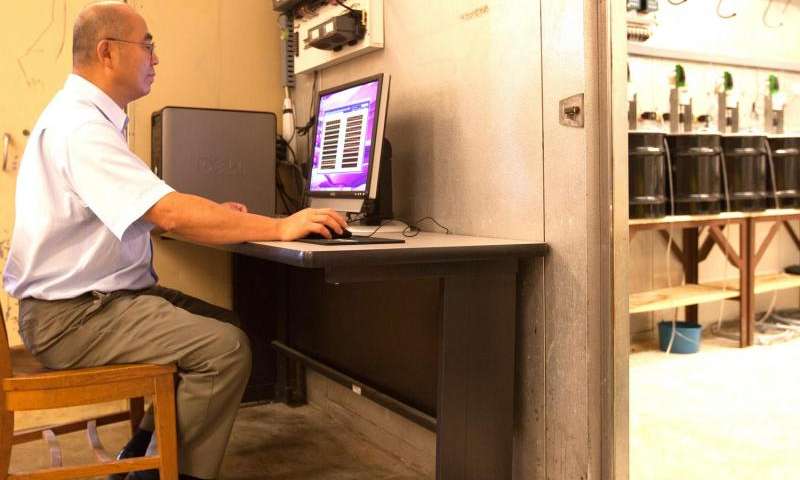
iqin Ni, an associate professor in Purdue’s Department of Agricultural and Biological Engineering, works in his lab to develop an on-site computer and software system for agriculture-based air quality research. The system consists of commercial data acquisition hardware, a personal computer, and custom-developed software to provide a more flexible, high-quality and user-friendly way to better understand and limit emission and pollution impact. Credit: Purdue University
Purdue University researchers are developing an on-site computer and software system that could provide a more flexible, high-quality and user-friendly way to conduct agriculture-based air quality research to better understand and limit emission and pollution impact.
Jiqin Ni, an associate professor, and Albert Heber, a professor, both in Purdue’s Department of Agricultural and Biological Engineering, invented the technology.
“Experimental study of agricultural air quality is critical to obtaining firsthand data for baseline emission determination, pollution impact assessment, modeling, and mitigation technology development,” Ni said. “These studies employ measurement devices, online instruments and sensors to obtain long-term data directly from laboratory or field setups. Essentially these studies could help to ensure air quality standards meet the criteria of the Clean Air Act.”
The Clean Air Act of 1970 is a comprehensive federal law that regulates air pollutant emissions from stationary and mobile sources. The law authorizes the U.S. Environmental Protection Agency to establish national ambient air quality standards to protect public health and public welfare to regulate emissions of hazardous air pollutants.
Heber said there are limitations with current environmental monitoring systems. “On-site computer systems were previously used exclusively for data acquisition, but as technology has progressed, such systems now are needed not only for data acquisition, but also device control, regular and advanced data processing, and communication,” he said. “These changes have demanded advancement in methodology and technology in comprehensive agriculture air quality research.”
The on-site computer system developed at Purdue consists of commercial data acquisition hardware, a personal computer, and custom-developed agriculture-based air quality research software, AirDAC. Additionally, the system uses commercial software for remote accessing and controlling via an internet connection.
“This system adapted a set of data processing algorithms, which allow the system to conduct real-time processing to configure with hardware channels, convert sensor signals, process and correct data, and control sampling and other devices,” Ni said. “Additionally, the algorithms are able to conduct post-measurement data processing of the previous day’s data. This includes separating the data from different sampling locations. It also extracts valid gas concentration data, calculates basic statistics, and draws daily data graphs for the researchers so that they can be informed about the ongoing measurement on time.”
Ni said the system has additional novel features. “This system includes an ‘all-data display and dynamic run-time configuration’, ‘digital output dynamic run-time configuration’, global channel, and traceable system operation,” Ni said. “The system also integrated two standalone instruments, an Innova multi-gas analyzer used for concentration measurement for up to six different gases, and an Environics multi-port gas dilution system, which is popular in air quality research. The design of the system allows more instruments to be integrated.”
Heber said this system has many benefits. “The most important part of our system is that it has multiple functions. It can acquire data from a variety of instruments and sensors, monitoring more than 200 simultaneously,” he said. “It’s also able to control the location, duration, sequence, and frequency of sampling that are needed for air quality monitoring. Additionally, it can control other devices such as heating and ventilation in a space, based on the measured temperature or other variables.”
Ni said the system is also user-friendly. “The system provides a novel user interface that is comprehensive yet compact and easy to use,” he said. “You’re able to change the parameters and it will all be automatically saved, providing maximum flexibility for different projects. New data processing functions can be added without changing the interface design. It also automatically communicates with researchers.”
The system has been used in EPA-supervised projects and other national projects, as well as licensed to industry and international institutions.
“It is readily applicable to most of the air quality studies, not limited to the agriculture sector, in laboratory and field conditions,” Ni said. “It is favorable for multi-institutional and international projects, where standardization of instrumentation and methods are required.”
[“Source-phys”]










